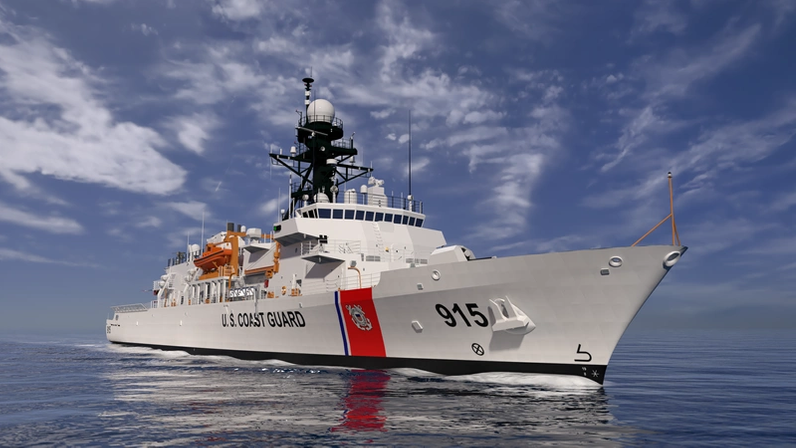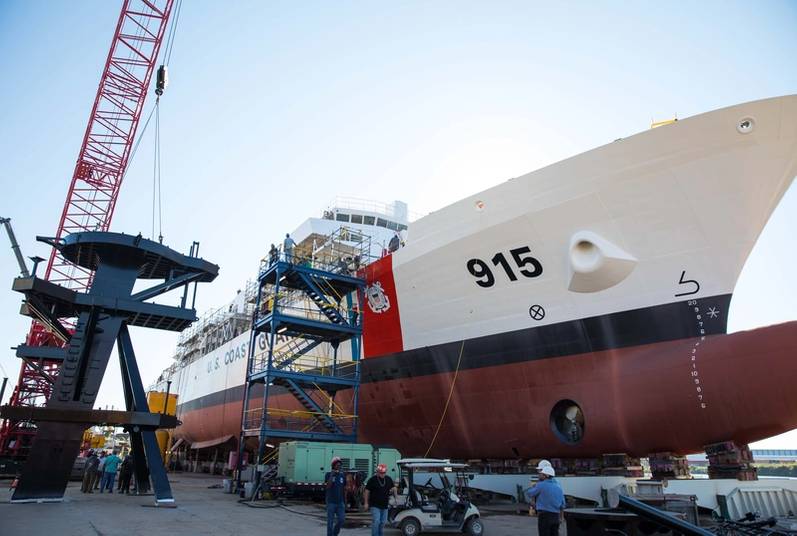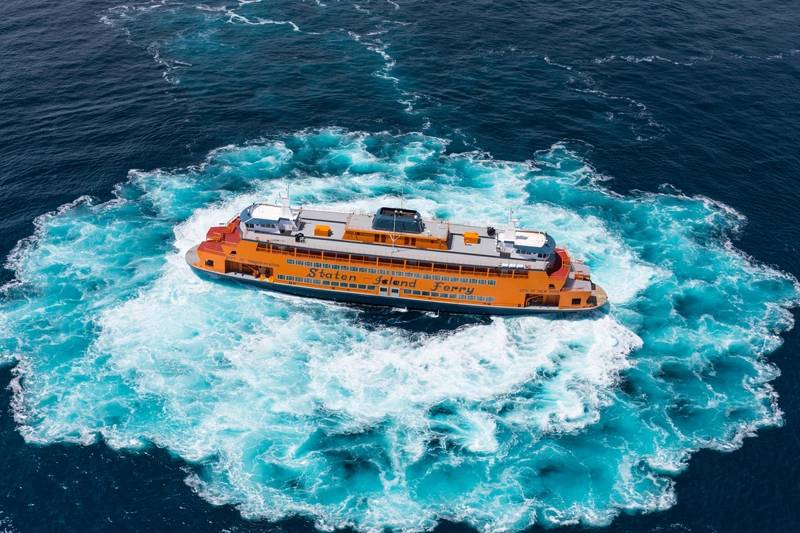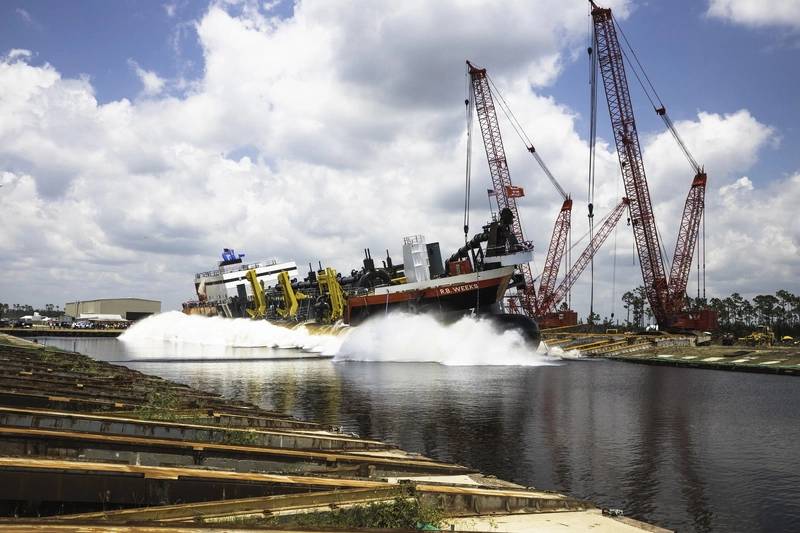What’s Next for Eastern Shipbuilding?
When Hurricane Michael slammed the Florida Panhandle in October 2018, the deadly category 5 storm inflicted billions in damages to the region, tearing apart homes and businesses in its path. Among those severely impacted was Eastern Shipbuilding Group, which suffered a nearly direct hit at its Allanton shipyard, located about 15 miles east of the company’s headquarters and main yard in Panama City.
Eastern, which had been scheduled to begin building the first of up to 11 Heritage-class Offshore Patrol Cutters (OPC) for the U.S. Coast Guard (USCG) in early 2019, was forced to shift into recovery mode as it worked to quickly build back from the heavy damages. Despite the builder’s rebound, the Coast Guard modified the OPC contract after Michael, and in 2019 it revised its acquisition strategy, opening a competitive bid process for OPCs five and through 15, essentially clearing way for Eastern and other U.S. shipyards to compete for the series’ next 11 vessels.
In June 2022, the Coast Guard announced Mobile, Ala. based Austal USA as the winner. Eastern, which had invested heavily to gear up for the OPC builds, including opening a new facility in Port St. Joe, has since contested the stage two award, citing unfair competitive advantage and conflict.
“In a normal procurement environment, the government process is designed to be fair and transparent, where the unsuccessful bidders have a chance to fully understand and evaluate the selection decision,” said Joey D’Isernia, president of Eastern Shipbuilding Group. “The government declined to participate in certain key portions of that process when we filed our initial complaint with the Government Accountability Office (GAO), so we were forced to go to the U.S. court of claims in order to have our protest grounds fully adjudicated. The Coast Guard owes Eastern and the American public justification for their selection decision and so far, it has not been provided.”
D’Isernia said he feels Eastern’s bid was the strongest and that the yard is ultimately best positioned to deliver the OPC series—the Coast Guard’s highest acquisition priority. “As the incumbent with a successful record, our proposal was the lowest-risk and the only one based on real world production of the OPC and historical actuals,” he said. “We are asking the court to overturn the improper decision and award the contract to Eastern. We feel strongly that we put forward the best proposal most closely aligned with the USCG’s stated intentions and are the right shipyard to build the OPCs for the men and women of the Coast Guard.”
 Eastern Shipbuilding Group is building the first four Heritage-class Offshore Patrol Cutters for the U.S. Coast Guard. (Credit: Eastern Shipbuilding Group)
Eastern Shipbuilding Group is building the first four Heritage-class Offshore Patrol Cutters for the U.S. Coast Guard. (Credit: Eastern Shipbuilding Group)
Ongoing OPC builds
Meanwhile, Eastern continues to build the first four OPC vessels, with deliveries scheduled from early 2023 through 2026. D’Isernia said the program is on schedule and within budget “despite a category 5 hurricane, a global pandemic and significant material shortages and supply chain challenges”.
Earlier this year, Eastern was awarded a large addition of scope to implement a major government modification in line with ongoing construction for the design, installation and integration of the multimode radar (MMR) and Aegis Baseline 9G (Athena) weapon system. “This provides the USCG with significant capability at delivery (Level 1 class 1 flight, full use of weapons systems, air search, etc.) that would have otherwise had to have been retrofitted post-delivery at great expense both to cost and schedule to the USCG,” D’Isernia said. “This in line change will result in a fully operational OPC in the hands of fleet operators years sooner than if the work was completed after ship delivery to the USCG.”
According to D’Isernia, the MMR and Athena contract modification is “a game-changer” in terms of capability for the vessel at delivery. “Implementation of the MMR and Athena allows the OPC lead hull to have fully functional, and advanced, air and surface surveillance; identification friend or foe (IFF); gun weapon system (GWS); electronic warfare (EW); navigation; decoy launching system (DLS); command, control and communication (C3); and flight deck launch and recovery capabilities at ship delivery,” he said. “By implementing these modifications now, ESG and the USCG will deliver capability years ahead of the previously planned post-delivery integration strategy which is a massive benefit to taxpayers and our national security, and is a significant demonstration of ESG’s design, integration, production and testing capabilities.”
 Eastern Shipbuilding Group is building the first four Heritage-class Offshore Patrol Cutters for the U.S. Coast Guard. (Credit: Eastern Shipbuilding Group)
Eastern Shipbuilding Group is building the first four Heritage-class Offshore Patrol Cutters for the U.S. Coast Guard. (Credit: Eastern Shipbuilding Group)
Notably, the additional scope of work pushes the delivery date into 2023 for the lead cutter, Argus, which as of this writing is 78% complete—fully erected and painted as workers outfit the ship to support launch.
Hull two, Chase, is 56% complete, mostly erected, with increasing levels of pre- and post-paint outfitting and unit completeness. The third hull, Ingham, is 29% complete, partly erected, applying lessons learned from the first two OPCs. And hull four, Rush, is 6% complete as initial units are being constructed ahead of scheduled delivery in 2026.
D’Isernia said Eastern tested the first OPC’s command, control, computers, communications, cyber, intelligence, surveillance and reconnaissance (C5ISR) suite in its C5 test and integration production facility (PF). Opened in 2021, the PF allows Eastern and its partners to fully test and integrate OPC C5ISR hardware and software under one roof, “a huge risk mitigator for the OPC program”, D’Isernia said. “Full testing of the OPC 1 C5ISR package successfully discovered and mitigated over a thousand small issues which would have otherwise been discovered on the ship during critical path testing resulting in significant degradation to program cost and schedule. It’s a huge and ongoing risk mitigator with hull two testing commencing now.”
The builder also discovered an issue with dimensional conformance of subcontractor supplied, and ABS witnessed/approved ship propulsion shafting. “ESG, USCG, ABS and our subcontractor, Rolls Royce, have been actively working on repair and replacement plans. Rolls Royce commenced repairs on hull one shaft sets with delivery of repaired shafting scheduled in the beginning of 2023,” D’Isernia said. “Rolls Royce produced modeling and analysis to demonstrate that the repaired shafting is suitable for operations and has also stepped up to the plate by committing to procuring compliant shaft sets to provide to the USCG as part of their eventual plan to deliver fully contract compliant shafting to OPC one before the ship’s first five-year availability and drydocking.
“For future ship sets, Rolls Royce has planned extensive oversight and execution plans to delivery first-time compliance. This is a first-of-class issue that was completely out of ESG’s control, and we want to thank Rolls Royce again for doing the right thing to support ESG and our customer.”
D’Isernia stressed the importance of its complex system of partners, suppliers and vendors: “We have partnered with some of the best and most experienced suppliers in the business to bring our superior OPC design to life. These industry partners understand and share our mission to make promises and keep them.
“The impact is felt across the U.S. with 35 states represented in our OPC program. This type of approach leverages resources from across the U.S., mitigates risk and ensures wide congressional support for this program. Through the pandemic and resulting supply chain challenges, our suppliers have helped push forward to keep the program on schedule. It is something we truly value and appreciate.”
 Eastern Shipbuilding Group is building the first four Heritage-class Offshore Patrol Cutters for the U.S. Coast Guard. (Credit: Eastern Shipbuilding Group)
Eastern Shipbuilding Group is building the first four Heritage-class Offshore Patrol Cutters for the U.S. Coast Guard. (Credit: Eastern Shipbuilding Group)
Commercial work
With roots that stretch back to 1976, Eastern has a long history delivering commercial vessels for both domestic and international customers, and D’Isernia said it has been Eastern’s priority to maintain commercial work as it executes its OPC program. “A challenge that we did not take lightly is how to excel in government shipbuilding without losing our competitiveness and agility on the commercial side of the business. We decided early on to completely segregate our commercial work from our government work, allowing us to be competitive in both arenas,” he explained.
“Our commercial customers don’t feel the impacts of the added processes and requirements brought on by government programs, and they are pleased to see that ESG is the same company they have done business with for decades. The facilities we have carved out to support commercial work are large and modern with ample capacity.
“Since being awarded the OPC contract, ESG has successfully built and delivered dozens of commercial vessels on time and on budget. Our aim is to continue to hold our significant position in the commercial shipbuilding market, while also successfully executing our government program.”
 Among notable recent commercial builds, Eastern Shipbuilding Group delivered a series of three Ollis-class vessels for the City of New York Department of Transportation (NYCDOT) Staten Island Ferry Division. (Credit: Eastern Shipbuilding Group)
Among notable recent commercial builds, Eastern Shipbuilding Group delivered a series of three Ollis-class vessels for the City of New York Department of Transportation (NYCDOT) Staten Island Ferry Division. (Credit: Eastern Shipbuilding Group)
Eastern is actively seeking to take on new government and commercial work, D’Isernia said. “As a small shipyard with government program capabilities and certifications, we are well positioned to support the U.S. Department of Defense (DoD) and Department of Homeland Security (DHS) in the government’s aggressive fleet acquisition and conversion plans. We are also pursuing offshore wind, liquefied natural gas (LNG) bunkering, and dredging markets where we have significant experience in large, complicated projects very similar to service operation vessels (SOV).”
Eastern is among a number of U.S. shipbuilders looking for business within the U.S.’ growing offshore wind industry. In the years ahead, a fleet of newbuild and retrofitted vessels will be required to build and service new wind farms, first along the U.S. East Coast, and then off the West and in the Gulf of Mexico and Great Lakes. “We are actively bidding multiple projects in the offshore wind market. These offshore wind support and installation vessels are complicated from a design and construction standpoint, and our shipyard has a proven track record within the industry for completing large, complicated projects like these on time and within budget.” D’Isernia said.
The company is also expanding its repair capabilities. “With the launch of our Port St. Joe Shipyard, a 40-acre site that encompasses 1,000 feet of deep-water bulkhead with unrestricted access to the Gulf of Mexico test and trials grounds, we have opened our repair side business line to help existing owners repair and convert their vessels. This is also the planned future site of ESG’s 15,000 ton drydock that will have certifications that allow for the drydocking of both commercial and government vessels.”
 In June, Eastern Shipbuilding Group launched the R.B. Weeks, the second trailing suction hopper dredge the Florida shipbuilder has constructed for Weeks Marine, Inc. (Credit: Eastern Shipbuilding Group)
In June, Eastern Shipbuilding Group launched the R.B. Weeks, the second trailing suction hopper dredge the Florida shipbuilder has constructed for Weeks Marine, Inc. (Credit: Eastern Shipbuilding Group)
D’Isernia said balancing both commercial and government work is crucial to both Eastern and the nation. “The United States needs to keep an active defense industrial complex of tier 1 and tier 2 shipyards that can support our national defense and the fleet acquisition strategies of DoD and DHS. That is why it has been our strategy to successfully execute the OPC program while remaining competitive in the commercial shipbuilding arena.
“The Defense Contract Audit Agency (DCAA) and Defense Contract Management Agency (DCMA) certified business systems required to run government programs can take up to a decade to build from the ground up and come at a substantial investment of money, time and other resources. I am proud to say that ESG is one of the few, maybe the only, nontier-one shipyards to have these business systems and certifications in place.
“This means that ESG has become a shipbuilding resource of national importance and one that has the tools to manage not only the OPC program, but other future programs that support the Navy’s and USCG’s ambitious growth plans. Bottom line, ESG has the proven capability, capacity and systems in place to manage complex, government shipbuilding programs and to deliver high-quality, affordable vessels critical to our nation’s security.”
Also vital to the yard’s success is workforce development, something that has been a challenge for many businesses across shipbuilding and countless other industries. “We are hiring, with more than 200 open positions across our departments that offer skilled shipbuilding professionals lifelong career opportunities and competitive wages,” D’Isernia said, referencing the benefits package available to workers at Eastern Shipbuilding Group. “We raised first class craft level wages and have added comprehensive benefits, including retirement.”
In addition, Eastern is also working to secure its workforce of the future. “Because workforce retention is so critical, we have invested in the future generation of shipbuilders,” D’Isernia said. "We launched and/or secured funding for 12 career and technical education pipeline programs in the area and so that these students can gain a critical skillset that gives them job security in the town where they grew up.”














